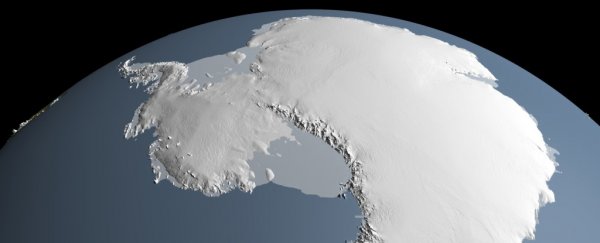Antarctica's ice sheet is the largest single mass of ice found anywhere on Earth, but what lies beneath is still largely a mystery.
Today, half the Antarctic ice sheet is more than 5 kilometres (3 miles) from any bed topography measurement, and major data gaps exist in several parts of this frigid continent.
Now, a detailed map of Antarctica's peaks and valleys has uncovered the deepest land canyon on Earth, in a narrow region known as Denman Glacier.
Stretching more than 3,500 metres (11,500 feet) below sea level, the land beneath this ice stream is nearly as deep as the average depth of the ocean, and eight times deeper than the shores of the Dead Sea, which is the lowest exposed land on Earth.
Previous airborne surveys over Antarctica relied mainly on radar and were not able to measure this trough's full depth. Whereas the newly released map, called BedMachine, can reach further under the ice than ever before.
"There have been many attempts to sound the bed of Denman, but every time they flew over the canyon - they couldn't see it in the radar data," Mathieu Morlighem, who studies ice sheet modelling at the University of California, Irvine, told BBC News.
"The trough is so entrenched that you get side-echoes from the walls of the valley and they make it impossible to detect the reflection from the actual bed of the glacier."
BedMachine is different because it combines information about ice flows and seismic activity along with radar to create the most detailed picture of Antarctica's landscape yet.
Drawing on data going all the back to 1967, gathered by 19 different research institutes, this topographical map includes nearly 1.5 million line kilometres of radar soundings; these can tell us a lot about how the land beneath Antarctica's ice will accelerate, slow down, or even stop the retreat of glaciers. (The same technique has already been used with great success in Greenland.)
"Older maps suggested a shallower canyon, but that wasn't possible; something was missing," says Morlighem.
Just as they suspected, the new measurements served up a bunch of surprises. For instance, the bed under the Recovery and Support Force glaciers turned out to be hundreds of metres deeper than previously predicted, meaning those ice sheets are at even greater risk of retreat in a warming world.
Similar to other results, researchers found that the regions most vulnerable to rapid marine ice retreat were mainly located in West Antarctica, such as the Thwaites and Pine Island glaciers.
But not every part of the continent is equally at risk. The Ross Sea sector and the Transantarctic Mountains appear to have the lowest chance of ice sheet instability because of their broad and stabilising ridges.
"Ultimately, BedMachine Antarctica presents a mixed picture," says Morlighem. "Ice streams in some areas are relatively well-protected by their underlying ground features, while others on retrograde beds are shown to be more at risk from potential marine ice sheet instability."
The Denman trough is located at a particularly tough spot. While other glaciers would have to retreat by 50 kilometres (31 miles) before they reached the retrograde bed (bedrock that slopes inland, making some glaciers prone to instability), this glacier's ice doesn't have nearly as much leeway.
"Close to the grounding line, the bed slope is gentle and slightly retrograde, which could lead to instability if the grounding line were to retreat inland, making this sector very vulnerable in East Antarctica, with a potential 1.5 metre sea level rise," the authors write.
Refining these results and reducing the uncertainty of such predictions will be absolutely crucial if we want to truly know how Antarctica's melting ice will contribute to sea level rise during the climate crisis.
Earlier this year, researchers found they could only explain our current sea level rise through the collapse of the West Antarctic ice sheet. And this region, they said, could easily add another three metres of sea level rise (10 feet).
The last time the world experienced carbon dioxide concentrations above 400 parts per million, a third of Antarctica's ice sheet melted, causing sea levels to rise by as much as 20 metres.
Since 1992, Antarctica has already lost 3 trillion tons of ice, and by the looks of things, that rate is only speeding up.
Finding out what lies underneath this continent's ice sheet is a matter of the utmost importance, and Morlighem hopes that in the future, they can incorporate sea floor depths to enhance their results even more.
The study was published in Nature Geoscience.
